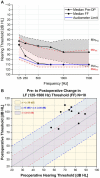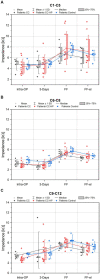Deep intracochlear injection of triamcinolone-acetonide with an inner ear catheter in patients with residual hearing
- PMID: 37564369
- PMCID: PMC10410142
- DOI: 10.3389/fnins.2023.1202429
Deep intracochlear injection of triamcinolone-acetonide with an inner ear catheter in patients with residual hearing
Abstract
Introduction: In a previous study, an inner ear catheter was used to deliver low- and high-dose steroids into the cochlea prior to cochlear implant electrode insertion. With this approach, more apical regions of the cochlea could be reached and a reduction of electrode impedances in the short term was achieved in cochlear implant recipients. Whether intracochlear application of drugs via the catheter is a safe method also for patients with residual hearing has not been investigated hitherto. The aim of the present study was therefore to investigate the effect of intracochlear triamcinolone application in cochlear implant recipients with residual hearing.
Patients and methods: Patients with residual hearing were administered triamcinolone-acetonide (4 mg/ml; n = 10) via an inner ear catheter just prior to insertion of a MED-EL FLEX28 electrode. Impedances were measured at defined time points (intra-operatively, post-operatively and at first fitting) and retrospectively compared with a control group (no steroid application) and low- and high-dose group. Hearing thresholds were measured preoperatively, 3 days after surgery and at first fitting by pure tone audiometry. Pre- to postoperative hearing loss was determined at first fitting and compared to results from a previous study.
Results: The median hearing loss after implantation (125-1,500 Hz) was 20.6 dB. Four patients (40%) showed a median hearing loss of less than 15 dB, three patients (30%) between 15 and 30 dB and three patients (30%) more than 30 dB. The median hearing loss was similar to the results obtained from our previous study showing a median hearing loss of 24 dB when using FLEX28 electrode arrays.
Conclusion: No difference in residual hearing loss was found when comparing application of triamcinolone-acetonide using an inner ear catheter prior to the insertion of a FLEX28 electrode array to the use of the FLEX28 electrode array without the catheter. Thus, we conclude that application of drugs to the cochlea with an inner ear catheter could be a feasible approach in patients with residual hearing.
Keywords: catheter; cochlear implant; drug delivery; hearing preservation; impedances; inner ear; steroids.
Copyright © 2023 Prenzler, Salcher, Lenarz, Gaertner, Lesinski-Schiedat and Warnecke.
Conflict of interest statement
The authors declare that the research was conducted in the absence of any commercial or financial relationships that could be construed as a potential conflict of interest.
Figures



Similar articles
-
Dose-Dependent Transient Decrease of Impedances by Deep Intracochlear Injection of Triamcinolone With a Cochlear Catheter Prior to Cochlear Implantation-1 Year Data.Front Neurol. 2020 Apr 15;11:258. doi: 10.3389/fneur.2020.00258. eCollection 2020. Front Neurol. 2020. PMID: 32390924 Free PMC article.
-
Intracochlear Electrocochleography: Response Patterns During Cochlear Implantation and Hearing Preservation.Ear Hear. 2019 Jul/Aug;40(4):833-848. doi: 10.1097/AUD.0000000000000659. Ear Hear. 2019. PMID: 30335669 Free PMC article.
-
Intracochlear administration of steroids with a catheter during human cochlear implantation: a safety and feasibility study.Drug Deliv Transl Res. 2018 Oct;8(5):1191-1199. doi: 10.1007/s13346-018-0539-z. Drug Deliv Transl Res. 2018. PMID: 29761349
-
Outcomes review of modern hearing preservation technique in cochlear implant.Auris Nasus Larynx. 2016 Oct;43(5):485-8. doi: 10.1016/j.anl.2016.02.014. Epub 2016 Mar 11. Auris Nasus Larynx. 2016. PMID: 26976547 Review.
-
Robotic assistance during cochlear implantation: the rationale for consistent, controlled speed of electrode array insertion.Front Neurol. 2024 Jan 22;15:1335994. doi: 10.3389/fneur.2024.1335994. eCollection 2024. Front Neurol. 2024. PMID: 38318440 Free PMC article. Review.
Cited by
-
Insertion trauma of a novel inner ear catheter for intracochlear drug delivery.Front Vet Sci. 2024 Jun 6;11:1397554. doi: 10.3389/fvets.2024.1397554. eCollection 2024. Front Vet Sci. 2024. PMID: 38903692 Free PMC article.
-
Drug selection for inner ear therapy.Front Pharmacol. 2024 Oct 17;15:1452927. doi: 10.3389/fphar.2024.1452927. eCollection 2024. Front Pharmacol. 2024. PMID: 39484167 Free PMC article.
-
Preclinical evaluation of a hydraulic actuation system with guide tube for robotic cochlear implant electrode insertion.Biomed Eng Online. 2025 Feb 14;24(1):19. doi: 10.1186/s12938-025-01338-z. Biomed Eng Online. 2025. PMID: 39953541 Free PMC article.
References
LinkOut - more resources
Full Text Sources
Miscellaneous

